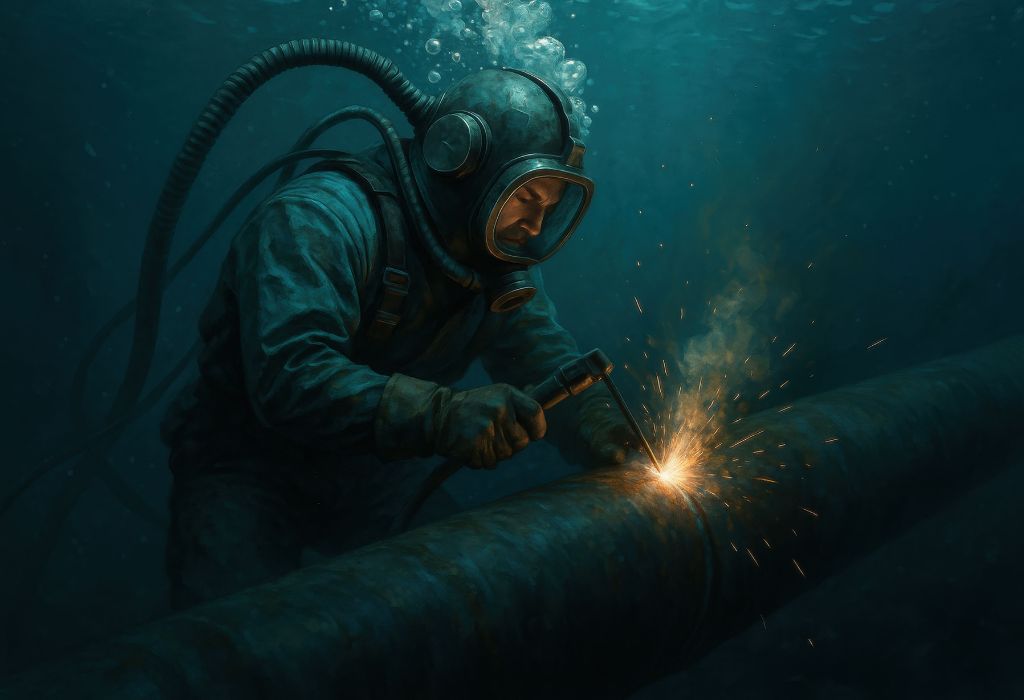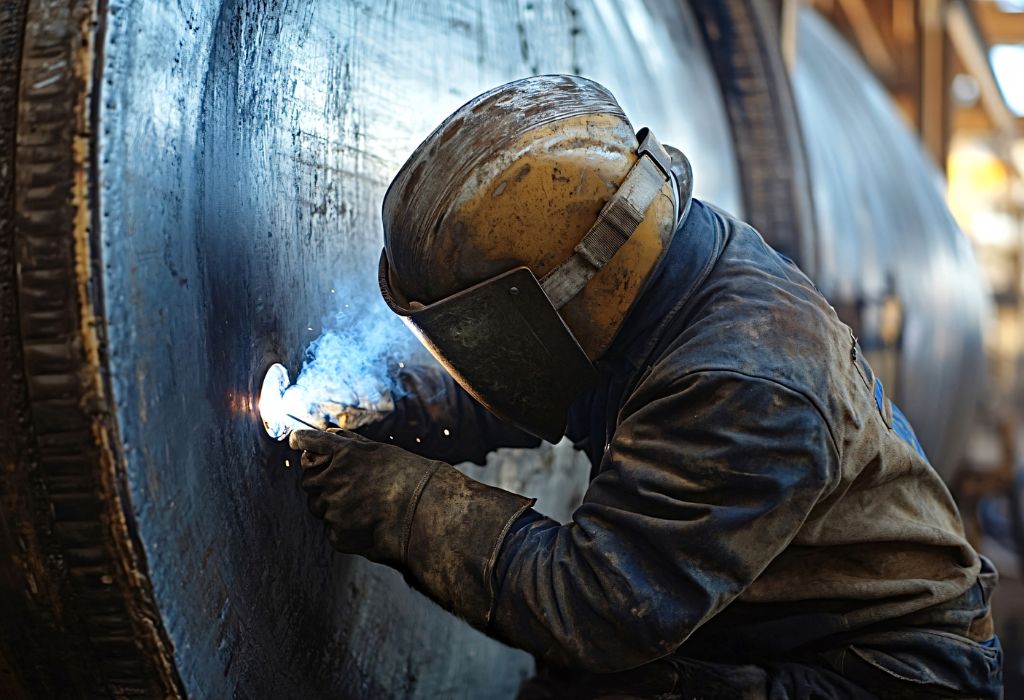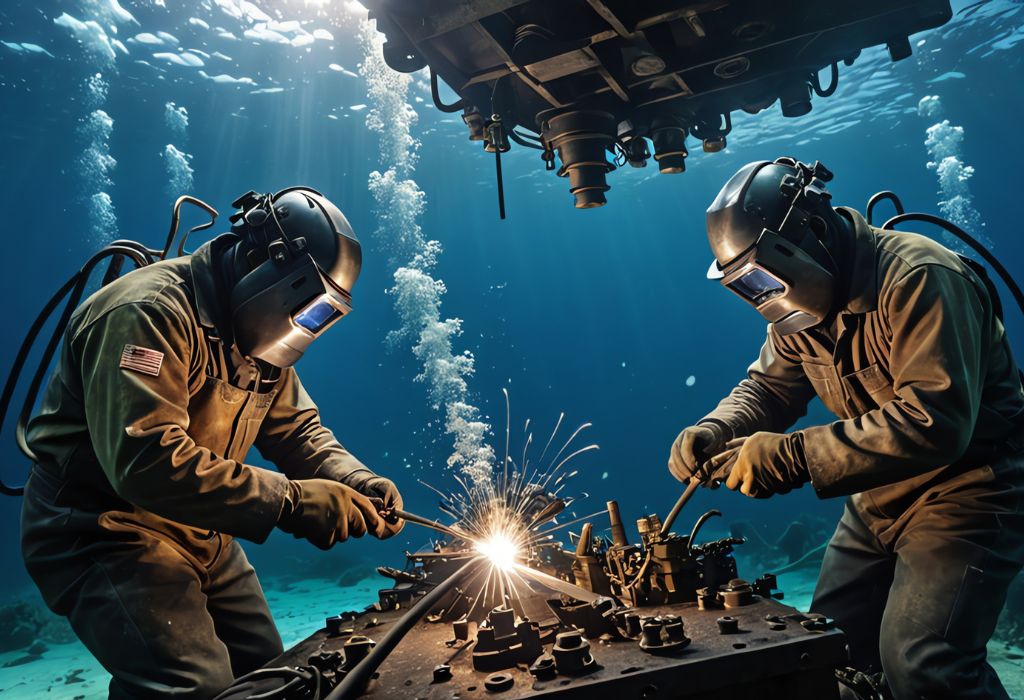A welder stands at a harbor watching divers surface after repairing a corroded piling. The mix of skill, danger, and pay sparks a powerful question: how to become a diver welder.
This path combines the precision of welding with the intensity of commercial diving. Few careers demand such physical fitness, technical expertise, and resilience under extreme conditions.
The rewards, however, are notable. Commercial divers in the U.S. report median earnings of around $63,000 annually, with top offshore or saturation divers earning significantly more (BLS).
But higher income is not the only draw. Underwater welders contribute to critical projects—maintaining bridges, repairing oil platforms, and supporting global infrastructure. The work has real impact beyond financial benefits.
The journey is challenging. Candidates must first prove their welding skills topside, then pass a strict commercial diving medical exam.
Training continues in accredited dive schools, where students learn physics of diving, underwater tools, and emergency procedures.
Certifications from organizations like ADCI, IMCA, or AWS verify competence.
Employers then expect divers to build logbooks through tendering and supervised jobs before advancing to full underwater welding roles.
Safety remains central throughout. Risks like decompression sickness, electrical hazards, and poor visibility make strict adherence to procedures essential.
Even experienced diver welders emphasize preparation over bravado.
This guide breaks down each step clearly, from prerequisites to training, costs, certifications, and job outlook.
By the end, readers will know what it truly takes to succeed in this demanding but rewarding profession.
Quick Answer — How to Become a Diver Welder

The fastest route to becoming a diver welder is to first master topside welding. Strong skills in SMAW, GMAW, and GTAW give a foundation for underwater work.
Next, pass a commercial diving medical exam. This ensures physical fitness and safety under pressure.
Enroll in an ADCI or IMCA accredited dive school, where training covers physics of diving, surface-supplied equipment, and underwater tools.
Earn underwater welding certifications such as AWS D3.6M. These qualifications prove competence to employers and open entry-level roles.
Finally, gain experience as a tender before welding underwater. Logbooks, supervised projects, and strong performance lead to higher-paying assignments.
What’s the fastest route to become a diver welder?
Master topside welding, attend accredited dive school, and pass underwater weld tests.
How long does it usually take?
About 6–18 months from training start to first paid dive jobs.
Can someone skip welding certifications?
No, topside welding skills are essential before underwater training.
Do you start welding on day one underwater?
No, most begin as tenders before advancing to welding dives.
Is accreditation important?
Yes, employers require ADCI, IMCA, or HSE-recognized qualifications.
What a Diver Welder Actually Does
Diver welders combine two specialized careers into one. They perform welding, cutting, inspection, and repair in underwater environments.
Tasks range from patching ship hulls to installing subsea pipelines. Inland jobs cover bridges and dams, while offshore jobs focus on rigs and platforms.
Work conditions vary from shallow river projects to deep offshore habitats. Team coordination with dive supervisors, riggers, and inspectors is essential.
Underwater welding is only part of the job. Many assignments include burning, fitting, rigging, and inspection support.
Wet vs dry welding?
Wet is performed directly in water, dry uses sealed habitats for code-quality welds.
Inland vs offshore work?
Inland covers ports, dams, and locks, offshore covers oil platforms and pipelines.
Do divers only weld?
No, they also cut, fit, and handle inspection support.
Who leads projects?
The diving supervisor directs all underwater operations.
Is teamwork critical?
Yes, diver welders rely on surface crews and supervisors.
Eligibility — Health, Fitness, and Background Checks
To qualify, candidates must pass a strict commercial diving medical exam. This checks cardiovascular health, ENT conditions, and lung function.
Physical fitness is vital. Stamina, strength, and the ability to work under pressure are tested in dive school swim assessments.
Drug tests and background checks are common. Offshore workers in the U.S. also need a TWIC card for port access.
A valid passport is required for international work. Employers expect flexibility for global contracts.
Do you need perfect vision?
Corrected vision is usually acceptable.
Can smokers qualify?
Smoking reduces performance and may affect medical clearance.
Is there an age limit?
No set limit, but fitness matters more than age.
Are swimming skills tested?
Yes, candidates must pass stamina and swim tests.
Are background checks required?
Yes, especially for offshore and port work.
Training Path — From Topside Welder to Commercial Diver
The first step is strong topside welding skills. Employers expect proficiency in processes like SMAW, GMAW, and GTAW.
Next, candidates apply to an accredited dive school. Programs recognized by ADCI, IMCA, or HSE ensure global job opportunities.
Dive training covers surface-supplied diving, physics of gases, emergency protocols, and underwater tool handling. Students learn rigging and hydraulics.
Graduates leave with essential dive certifications and basic underwater welding exposure. Many begin working as tenders before welding underwater.
Is welding experience mandatory?
Yes, it shortens training and improves employability.
How long is dive school?
Usually 5–12 months depending on the program.
Are scholarships available?
Some schools and trade groups offer funding options.
Which bodies accredit schools?
ADCI, IMCA, HSE, and DCBC depending on region.
What skills are taught in school?
Diving physics, safety, communications, and tool handling.
Underwater Welding Certifications and Codes

Certification proves competence. Employers expect recognized welding codes for underwater work.
The AWS D3.6M standard is one of the most common. It covers wet welding and habitat welding tests.
Other codes include EN ISO 15618 and CSWIP underwater welding certifications. Companies may also issue procedure-specific tests.
Tests include weld plates, visual inspection, and nondestructive testing. Habitat welds must often meet x-ray quality standards.
Which certification is most common?
AWS D3.6M is widely accepted.
Is habitat welding tested differently?
Yes, it follows dry welding code standards.
How often must certifications be renewed?
Continuity records are required, often every 6 months.
Can certifications be earned at dive school?
Many schools offer witnessed tests.
Do employers retest welders?
Yes, most companies conduct in-house procedures.
Gear, Costs, and Funding Options
Training is expensive. Dive school tuition, medical exams, and travel costs add up quickly.
Schools often provide helmets and umbilicals during training. Later, divers may invest in personal helmets and tools.
Employers typically supply heavy gear for offshore projects. However, divers should plan for basic kits, insurance, and sea bags.
Funding options include grants, veterans’ benefits, and scholarships. Planning ahead prevents delays.
What’s the average school cost?
Several thousand to tens of thousands of dollars.
Do divers need to buy helmets?
Not at first; employers often provide them.
Are there hidden costs?
Yes, medicals, immunizations, and travel.
Can veterans use benefits?
Many programs accept VA funding.
Is insurance required?
Yes, divers must have coverage.
Inland vs Offshore vs Saturation — Choosing a Track
Inland diving involves ports, bridges, and dams. It usually offers regular schedules but lower pay.
Offshore diving covers rigs, pipelines, and platforms. Pay is higher but involves long hitches and travel.
Saturation diving allows long-duration projects at depth. Divers live pressurized for weeks, earning premium day rates.
Each path has unique demands. Beginners often start inland or as offshore tenders before advancing.
Which pays most?
Offshore and saturation roles.
Which is best for beginners?
Inland or entry-level offshore tender jobs.
Is saturation required?
No, it is a specialized path.
How long are offshore trips?
Usually 2–6 weeks.
Is inland safer?
Generally, but risks still exist.
Safety, Risk, and Regulations You Must Know
Underwater welding has inherent risks. Hazards include decompression illness, entanglement, delta-P, and poor visibility.
Strict procedures manage these dangers. Job hazard analysis, standby divers, and permit systems are essential controls.
OSHA, USCG, and IMCA provide standards for dive operations. Employers must comply with these regulations.
Safety training is continuous. Divers must treat procedures as non-negotiable.
Is underwater welding safe?
Risks are controlled with training and protocols.
Who regulates dive work?
OSHA in the U.S., HSE in the U.K., IMCA offshore.
What reduces accidents?
Planning, supervision, and equipment checks.
Do divers need insurance?
Yes, through employers or unions.
Are standby divers always present?
Yes, it is a safety requirement.
Building Experience — From Tender to Welder
Most divers start as tenders. They manage hoses, tools, and deck tasks while logging hours.
Tenders gain valuable learning. Observing senior divers builds knowledge before entering the water.
A logbook is vital. Supervisors sign entries that prove experience and readiness.
Progress depends on performance. Consistent work leads to welding opportunities faster.
How long as a tender?
6–24 months is common.
What proves readiness?
Strong logs and successful weld tests.
Can tenders weld topside?
Yes, and it helps progression.
Who promotes tenders?
Supervisors and company leadership.
Do all tenders advance?
Only those who perform well.
Pay, Day Rates, and Contracts
Pay depends on role, location, and specialization. Inland divers often earn hourly rates, while offshore jobs pay day rates.
Hazard pay, overtime, and per diem allowances increase earnings. Saturation divers earn the highest rates.
Benefits vary by contractor. Some include healthcare, insurance, and travel coverage.
Earnings rise with certifications and logged experience.
What are typical starter wages?
Tender rates inland, higher offshore.
Do certifications boost pay?
Yes, especially underwater weld codes.
Are benefits included?
Many employers provide them.
Can divers earn six figures?
Yes, with offshore or saturation work.
Do pay models vary?
Yes, hourly inland vs day-rate offshore.
Job Search — Portfolios, Networks, and Interviews
A strong portfolio helps. Include weld photos, WPS records, and test results.
A CV should list certifications, medicals, and dive logs. Employers want clear proof of skills.
Networking is essential. Dive schools, supervisors, unions, and LinkedIn groups are good channels.
Relocation may be required. Opportunities follow projects worldwide.
Do photos matter?
Yes, they prove quality of work.
Who should be contacted first?
Dive contractors and coordinators.
Are test plates required?
Many shops require them.
Should divers relocate?
Yes, when pay offsets costs.
Do references help?
Strong references increase chances.
Timeline & Checklist — How to Become a Diver Welder in 6–18 Months

Becoming a diver welder takes planning. A realistic path is 6–18 months.
Start by gaining topside welding skills. Pass a dive medical and apply to accredited schools.
Complete training, then earn underwater weld certifications. Begin work as a tender to log hours.
Advance to supervised welds, then to full diver welder positions.
What slows progress?
Medical issues or failed tests.
What speeds it up?
Strong topside welding and fitness.
Do seasons matter?
Yes, some work is seasonal.
Is mentorship useful?
Yes, it accelerates learning.
Can timelines vary?
Yes, depending on funding and jobs.
Common Mistakes to Avoid
Many beginners underestimate fitness requirements. This leads to failed medicals or training delays.
Skipping topside welding experience is another error. Poor welds fail underwater tests quickly.
Some overspend on personal gear too early. Employers often provide heavy equipment.
Others chase saturation diving before gaining experience. This path requires patience.
What is the biggest mistake?
Weak topside welding skills.
Should beginners buy helmets?
No, wait until required.
Do logbooks matter?
Yes, they prove experience.
Is rushing into sat work wise?
No, it comes after years of diving.
Do many fail because of fitness?
Yes, medicals are strict.
Future Trends — Robotics, NDT, and Habitat Innovation
Technology is changing underwater welding. ROVs now assist divers with inspection and cutting.
However, skilled welders remain essential for complex repairs. Robots cannot yet replace human judgment in the water.
New habitats allow faster setups and improved welding environments. NDT skills add flexibility to diver welder roles.
Renewable energy projects are increasing demand. Offshore wind farms and port expansions require underwater welding.
Will robots replace divers?
No, they assist but cannot weld complex joints.
Is NDT certification useful?
Yes, it increases employability.
Do renewables create work?
Yes, offshore wind and ports drive demand.
What skills future-proof careers?
Welding codes, safety, NDT, and habitat welding.
Is demand growing?
Yes, due to infrastructure and energy projects.
Conclusion
Becoming a diver welder is demanding but rewarding. It requires welding expertise, diving fitness, and strict adherence to safety.
The path includes topside skills, accredited dive training, underwater welding certifications, and experience as a tender.
Pay varies, but offshore and saturation roles can exceed six figures. Demand remains steady for skilled diver welders.
So, how to become a diver welder? Master topside welding, pass a dive medical, train at accredited schools, earn certifications, and log dives. With patience and discipline, this career offers both challenge and reward.

I’m Darrell Julian, the founder, lead writer, and hands-on welding enthusiast behind ArcWeldingPro.com. With more than 15 years of real-world welding experience, I created this platform to share what I’ve learned in the field, in the shop, and in the heat of the arc.


